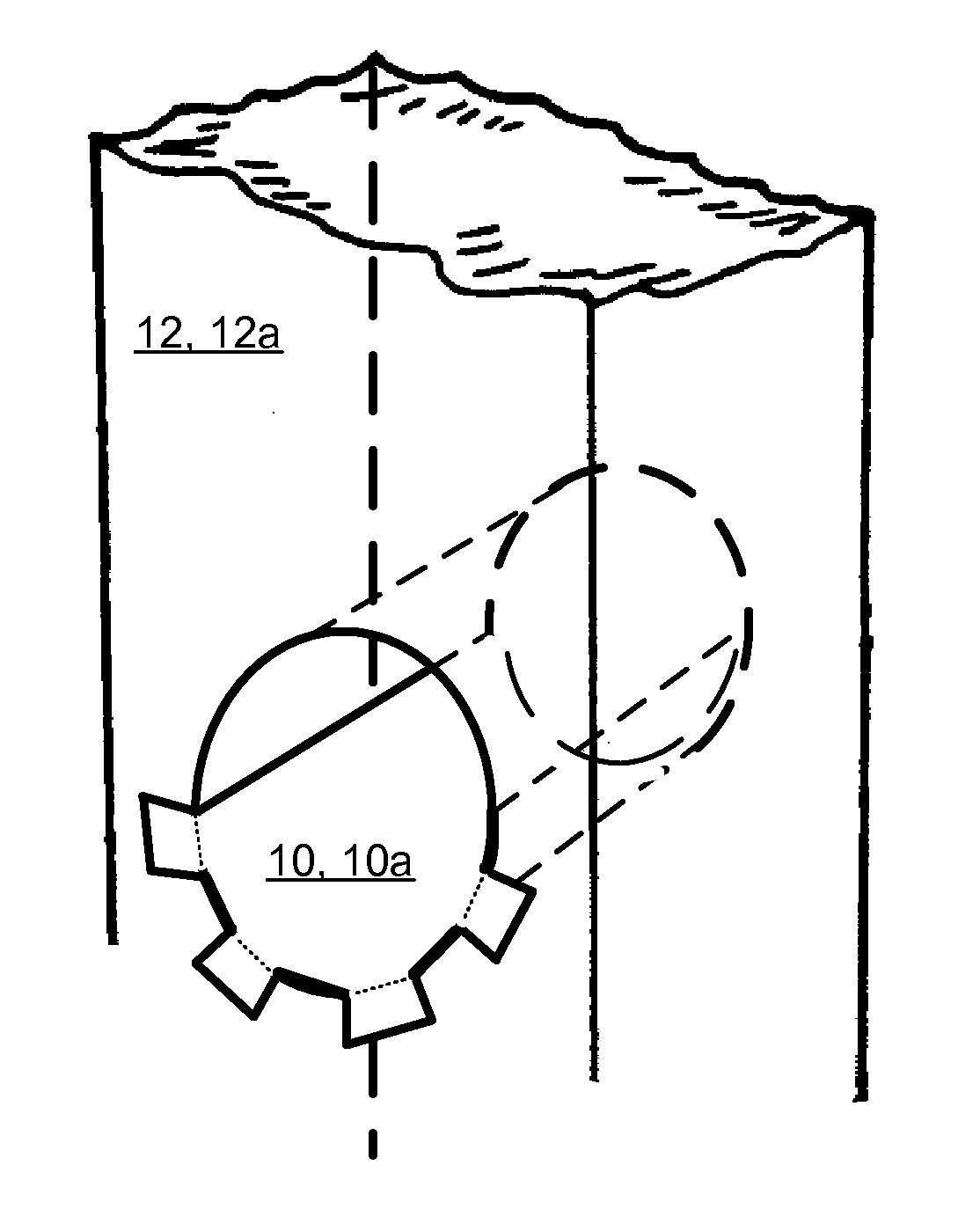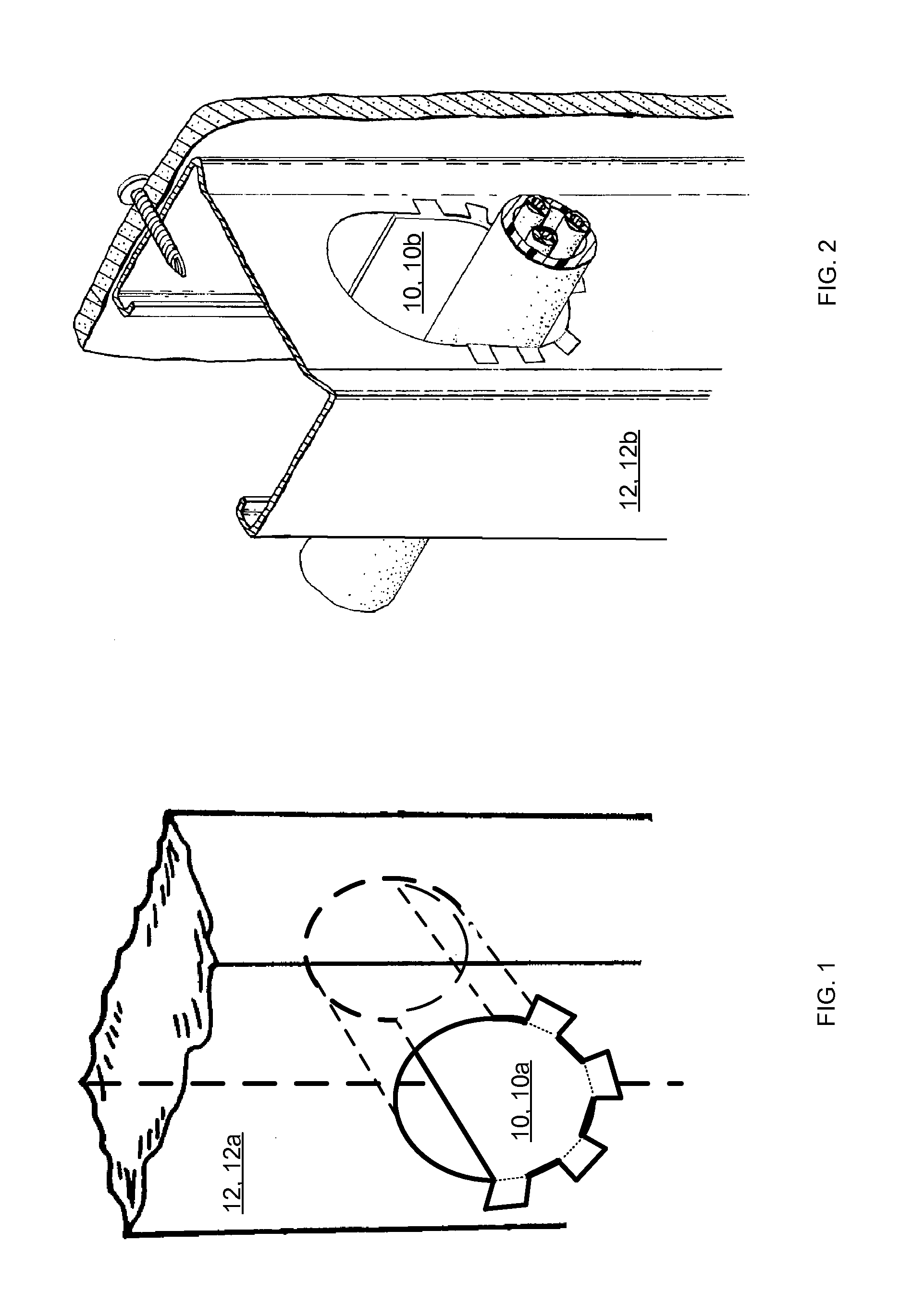This approach has been widely used in the past but is now largely out of favor because it is felt to unduly undermine stud and wall strength.
Additionally, for reasons that will be discussed presently, this approach undesirably puts utility conduits close to a wall surface, rather than in a wall center furthest away from all such surfaces.
Most walls today are covered by nailing or screwing wall cover material to the studs, thus exposing the conduits passing through the studs to the risk that one of these nails or screws will damage them.
Similarly, once utility conduits are “hidden” within a wall, they are at risk from anything that later penetrates the wall.
Potentially, such penetration can occur anywhere in a wall and all points of a utility conduit are thus seemingly at risk.
As a practical matter, however, such penetration usually is at studs and poses the greatest risk there.
If this hypothetical handy-person lacks foresight, and simply drives their nail into the wall anywhere, the chances are that it will not be driven into a stud and that the mirror will not be well secured.
Unfortunately, if per chance the nail in this
scenario is driven into a stud and there encounters a utility conduit, say, an electrical
power cable, the stud will tend to hold the cable relatively fixed and this will increase the likelihood that the nail will penetrate it, potentially shorting the conductors and starting a fire.
This solution is quite elaborate and material-intensive.
Unfortunately, all of the presently used approaches to shielding utility conduits have limitations or involve trade-offs.
For example, as noted above, all of the approaches that are specific for use with through-
notching are undesirable because through-
notching undermines the strength of the studs and ultimately the walls that they are part of.
Granted, the shielding over the through-notch should help protect the conduits within it, but this still brings the rest of the conduits closer to one wall and generally exposes them to possible damage by shorter penetrations.
All of the side-of-stud plate-based approaches, both for use over through-notches and through-holes, also have another inherent limitation.
But this is not necessarily always the case.
Obviously, this possibility is totally foreclosed if a
metal side-of-stud plate is used.
This can result in a wall covering having an aesthetically unpleasing buckled or warped appearance.
While flat plates with projections (teeth, prongs, or barbs) are easy to make (see e.g., Williamson's stud shield, discussed above), they also require an undue quantity of material to make.
Firstly, such a plate usually has to have portions extending above and below the through-notch or through-hole being covered for the projections that will be driven into a wooden stud.
Secondly, even when this is not the case (see e.g., Lalancette's plate for use in limited applications and Zastrow et al's
adhesive plate), side-of-stud plates need to extend more than the vertical width of the through-notch or
diameter of the through-hole to protect against nails or screws driven into a stud adjacent to the plate but at an angle such that utility conduits might still be damaged.
Side-of-stud plate-based approaches are also unsuitable for use after wall covering, e.g., for running new utility conduits in existing construction.
This material-intensive nature of plate-based approaches is not well appreciated in the industry, largely because it has slowly grown in importance and “conventional wisdom” is that plates are fine and their cost is simply one that must be endured.
The point here is that we have slowly grown to use roughly ten-fold as much utility conduit shielding as we once did, and the materials for that and their cost have become substantial.
Nonetheless, the multi-cylinder approach by Nelson and multi-sheath embodiments in accord with Wilkerson's approach are actually not economical with respect to the amount of material they require.
The problem is, however, that Wilkerson's sheaths have no mechanism other than
surface friction to retain them in a through-hole, and the greater the degree of taper they have the more likely they are to simply pop back out of a through-hole.
Using ¾″ or 1⅛″ bits will likely produce holes that will not work for 1″ Wilkerson sheaths.
Furthermore, with no significant retaining mechanism, Wilkerson sheaths are not reliably useable with sheet
metal type studs.
[Notably, Wilkerson's filing in 1954 pre-dates the significant use of sheet
metal studs and this reference does not teach the use of its sheathes in such.]
Similarly, Baillie's dimpled tubes are very economical with respect to material but have other limitations.
Also, even though the first of the patents for this was filed for in 1973, when sheet metal studs where becoming known, Baillie does not teach, and apparently it simply was not contemplated, that its dimpled tubes could be used in sheet metal studs.
Accordingly, the presently most widely used utility conduit protection scheme, plates affixed to stud edges, is uneconomical and has utilitarian limitations.
Similarly, all of the other known plate-based approaches suffer from at least the same problems.
Conversely, present center-of-stud specific approaches are either less economical than possible, also have utilitarian limitations, or both.
 Login to View More
Login to View More  Login to View More
Login to View More 


